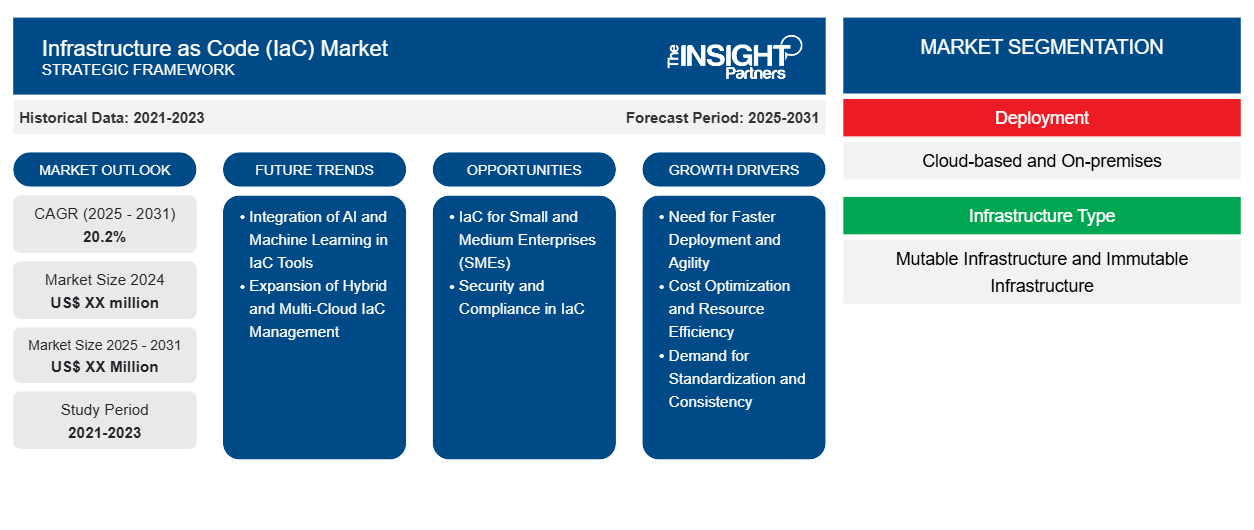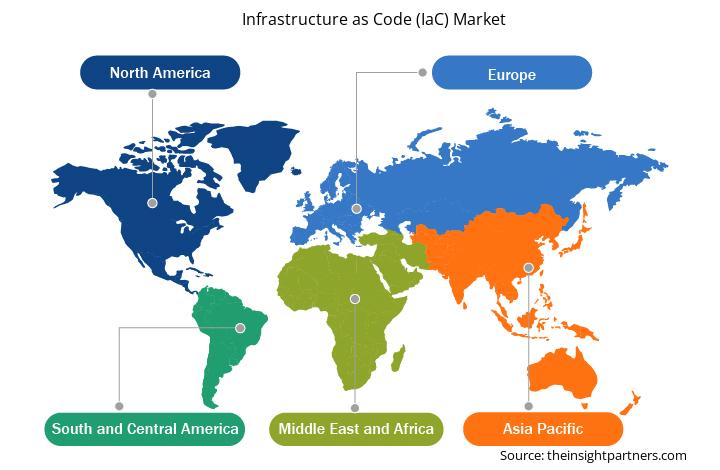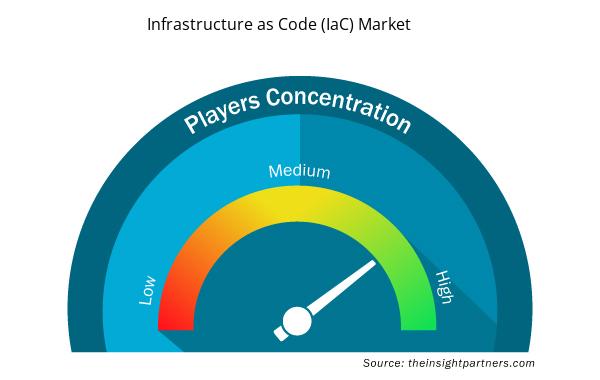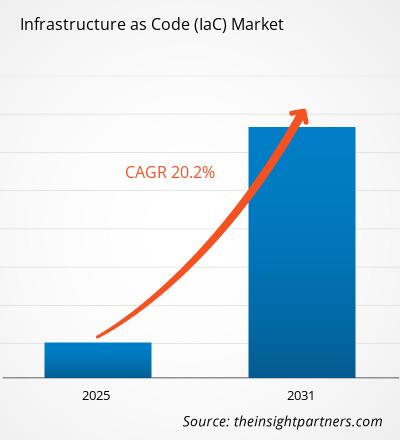Se espera que el mercado de infraestructura como código (IaC) registre una CAGR del 20,2 % entre 2025 y 2031, y que el tamaño del mercado se expanda de US$ XX millones en 2024 a US$ XX millones en 2031.
El informe está segmentado por implementación (en la nube y local), tipo de infraestructura (infraestructura mutable e inmutable), enfoque (imperativo y declarativo) y usuario final (BFSI, comercio minorista, gobierno, manufactura, TI y telecomunicaciones, salud y otros). El análisis global se desglosa a nivel regional y por países principales. El informe ofrece el valor en USD para el análisis y los segmentos mencionados.
Propósito del Informe
El informe "Mercado de Infraestructura como Código (IaC)" de The Insight Partners busca describir el panorama actual y el crecimiento futuro, los principales factores impulsores, los desafíos y las oportunidades. Esto proporcionará información a diversos actores del negocio, como:
- Proveedores/Fabricantes de Tecnología: Para comprender la dinámica cambiante del mercado y conocer las oportunidades potenciales de crecimiento, lo que les permitirá tomar decisiones estratégicas informadas.
- Inversores: Realizar un análisis exhaustivo de tendencias respecto a la tasa de crecimiento del mercado, las proyecciones financieras del mercado y las oportunidades que existen en toda la cadena de valor.
- Organismos reguladores: Regular las políticas y las actividades policiales en el mercado con el objetivo de minimizar el abuso, preservar la confianza de los inversores y defender la integridad y estabilidad del mercado.
Segmentación del mercado de infraestructura como código (IaC)
Despliegue
- Basado en la nube y en las instalaciones
Tipo de infraestructura
- Infraestructura mutable e infraestructura inmutable
Acercarse
- Imperativo y declarativo
Usuario final
- BFSI
- Minorista
- Gobierno
- Fabricación
- TI y telecomunicaciones
- Cuidado de la salud
Personalice este informe según sus necesidades
Recibirá personalización de cualquier informe, sin cargo, incluidas partes de este informe o análisis a nivel de país, paquete de datos de Excel, así como también grandes ofertas y descuentos para empresas emergentes y universidades.
Mercado de Infraestructura como Código (IaC): Perspectivas estratégicas

- Obtenga las principales tendencias clave del mercado de este informe.Esta muestra GRATUITA incluirá análisis de datos, desde tendencias del mercado hasta estimaciones y pronósticos.
Factores que impulsan el crecimiento del mercado de infraestructura como código (IaC)
- Necesidad de una implementación más rápida y ágil: Las organizaciones se centran cada vez más en acelerar los ciclos de desarrollo de software y optimizar el tiempo de comercialización. IaC permite un aprovisionamiento, una implementación y un escalado más rápidos de la infraestructura, lo que facilita DevOps y los canales de entrega continua. Esta búsqueda de agilidad y operaciones optimizadas en entornos de TI impulsa significativamente el mercado de IaC.
- Optimización de Costos y Eficiencia de Recursos: IaC automatiza la gestión de la infraestructura, reduciendo la necesidad de intervenciones manuales y minimizando el desperdicio de recursos. Esto se traduce en una mayor eficiencia de los recursos, ahorro de costos y un mejor uso de los servicios en la nube. A medida que las empresas buscan optimizar sus costos operativos, la adopción de IaC crece.
- Demanda de estandarización y consistencia: IaC permite la estandarización de las implementaciones de infraestructura en diferentes entornos (p. ej., desarrollo, pruebas, producción). Al codificar las configuraciones, garantiza la consistencia de las configuraciones de la infraestructura, reduce las desviaciones y errores de configuración, y mejora la confiabilidad general del sistema. Esta demanda de procesos consistentes y repetibles impulsa la adopción de IaC.
Tendencias futuras del mercado de infraestructura como código (IaC)
- Integración de IA y aprendizaje automático en herramientas de IaC: Se prevé un crecimiento de la integración de tecnologías de IA y aprendizaje automático en soluciones de IaC. Estas tecnologías pueden optimizar la asignación de recursos, predecir las necesidades de infraestructura y automatizar la detección de anomalías. Las herramientas de IaC basadas en IA mejorarán la eficiencia operativa, reducirán el tiempo de inactividad y agilizarán la gestión de entornos de infraestructura complejos.
- Expansión de la gestión de IaC híbrida y multicloud: A medida que las organizaciones adoptan estrategias híbridas y multicloud, la gestión de la infraestructura en diferentes entornos de nube se volverá más compleja. Las soluciones de IaC evolucionarán para facilitar una gestión fluida en arquitecturas híbridas y multicloud, lo que permitirá a las organizaciones aprovisionar, configurar y gestionar la infraestructura en diversos proveedores de nube y entornos locales.
Oportunidades de mercado de infraestructura como código (IaC)
- IaC para pequeñas y medianas empresas (PYME): Si bien las grandes empresas han adoptado soluciones de IaC, existe una gran oportunidad para proporcionar herramientas de IaC personalizadas y fáciles de usar para ellas. Estas soluciones pueden ayudar a las PYME a automatizar la gestión de la infraestructura, reducir la intervención manual y garantizar la consistencia sin requerir una amplia experiencia técnica ni grandes presupuestos, lo que facilita el acceso de la IaC a un mercado más amplio.
- Seguridad y cumplimiento normativo en IaC: A medida que las herramientas de IaC automatizan el aprovisionamiento de infraestructura, también deben garantizar la seguridad y el cumplimiento normativo. Ofrecer soluciones de IaC que integren las mejores prácticas de seguridad, el análisis de vulnerabilidades y las comprobaciones de cumplimiento normativo generará oportunidades en sectores como el financiero, el sanitario y el gubernamental, donde la seguridad y el cumplimiento normativo son cruciales. Este nicho de mercado experimentará un crecimiento significativo a medida que la seguridad se convierta en una prioridad en la gestión de infraestructura.
Perspectivas regionales del mercado de infraestructura como código (IaC)
Los analistas de Insight Partners han explicado detalladamente las tendencias y los factores regionales que influyen en el mercado de Infraestructura como Código (IaC) durante el período de pronóstico. Esta sección también analiza los segmentos y la geografía del mercado de Infraestructura como Código (IaC) en Norteamérica, Europa, Asia Pacífico, Oriente Medio y África, y Sudamérica y Centroamérica.

- Obtenga los datos regionales específicos para el mercado de Infraestructura como Código (IaC)
Alcance del informe de mercado de Infraestructura como Código (IaC)
| Atributo del informe | Detalles |
|---|---|
| Tamaño del mercado en 2024 | US$ XX millones |
| Tamaño del mercado en 2031 | US$ XX millones |
| CAGR global (2025-2031) | 20,2% |
| Datos históricos | 2021-2023 |
| Período de pronóstico | 2025-2031 |
| Segmentos cubiertos | Por implementación
|
| Regiones y países cubiertos | América del norte
|
| Líderes del mercado y perfiles de empresas clave |
|
Densidad de actores del mercado de infraestructura como código (IaC): comprensión de su impacto en la dinámica empresarial
El mercado de Infraestructura como Código (IaC) está creciendo rápidamente, impulsado por la creciente demanda de los usuarios finales debido a factores como la evolución de las preferencias de los consumidores, los avances tecnológicos y una mayor comprensión de los beneficios del producto. A medida que aumenta la demanda, las empresas amplían su oferta, innovan para satisfacer las necesidades de los consumidores y aprovechan las tendencias emergentes, lo que impulsa aún más el crecimiento del mercado.
La densidad de actores del mercado se refiere a la distribución de empresas o compañías que operan en un mercado o sector en particular. Indica cuántos competidores (actores del mercado) hay en un mercado determinado en relación con su tamaño o valor total.
Las principales empresas que operan en el mercado de Infraestructura como Código (IaC) son:
- IBM
- Microsoft
- AWS
- Oráculo
- Hashicorp Terraform
Descargo de responsabilidad : Las empresas enumeradas anteriormente no están clasificadas en ningún orden particular.

- Obtenga una descripción general de los principales actores clave del mercado de Infraestructura como Código (IaC)
Puntos clave de venta
- Cobertura integral: el informe cubre exhaustivamente el análisis de productos, servicios, tipos y usuarios finales del mercado de Infraestructura como Código (IaC), proporcionando un panorama holístico.
- Análisis de expertos: el informe se compila con base en el conocimiento profundo de expertos y analistas de la industria.
- Información actualizada: El informe asegura relevancia comercial debido a su cobertura de información reciente y tendencias de datos.
- Opciones de personalización: este informe se puede personalizar para satisfacer los requisitos específicos del cliente y adaptarse adecuadamente a las estrategias comerciales.
Por lo tanto, el informe de investigación sobre el mercado de Infraestructura como Código (IaC) puede ayudar a liderar el camino para decodificar y comprender el panorama de la industria y sus perspectivas de crecimiento. Si bien existen algunas preocupaciones válidas, las ventajas generales de este informe tienden a superar las desventajas.
- Análisis histórico (2 años), año base, pronóstico (7 años) con CAGR
- Análisis PEST y FODA
- Tamaño del mercado Valor/volumen: global, regional, nacional
- Industria y panorama competitivo
- Conjunto de datos de Excel



Report Coverage
Revenue forecast, Company Analysis, Industry landscape, Growth factors, and Trends

Segment Covered
This text is related
to segments covered.

Regional Scope
North America, Europe, Asia Pacific, Middle East & Africa, South & Central America

Country Scope
This text is related
to country scope.
Preguntas frecuentes
Some of the customization options available based on the request are an additional 3–5 company profiles and country-specific analysis of 3–5 countries of your choice. Customizations are to be requested/discussed before making final order confirmation# as our team would review the same and check the feasibility
The report can be delivered in PDF/PPT format; we can also share excel dataset based on the request
Integration of AI and Machine Learning in IaC Tools and Expansion of Hybrid and Multi-Cloud IaC Management are anticipated to play a significant role in the global Infrastructure as Code (IaC) market in the coming years
Need for Faster Deployment and Agility and Cost Optimization and Resource Efficiency are the major factors driving the Infrastructure as Code (IaC) market
The global infrastructure as code (iac) marketis expected to grow at a CAGR of 20.2% from 2024 to 2031
Trends and growth analysis reports related to Technology, Media and Telecommunications : READ MORE..
The Insight Partners performs research in 4 major stages: Data Collection & Secondary Research, Primary Research, Data Analysis and Data Triangulation & Final Review.
- Data Collection and Secondary Research:
As a market research and consulting firm operating from a decade, we have published and advised several client across the globe. First step for any study will start with an assessment of currently available data and insights from existing reports. Further, historical and current market information is collected from Investor Presentations, Annual Reports, SEC Filings, etc., and other information related to company’s performance and market positioning are gathered from Paid Databases (Factiva, Hoovers, and Reuters) and various other publications available in public domain.
Several associations trade associates, technical forums, institutes, societies and organization are accessed to gain technical as well as market related insights through their publications such as research papers, blogs and press releases related to the studies are referred to get cues about the market. Further, white papers, journals, magazines, and other news articles published in last 3 years are scrutinized and analyzed to understand the current market trends.
- Primary Research:
The primarily interview analysis comprise of data obtained from industry participants interview and answers to survey questions gathered by in-house primary team.
For primary research, interviews are conducted with industry experts/CEOs/Marketing Managers/VPs/Subject Matter Experts from both demand and supply side to get a 360-degree view of the market. The primary team conducts several interviews based on the complexity of the markets to understand the various market trends and dynamics which makes research more credible and precise.
A typical research interview fulfils the following functions:
- Provides first-hand information on the market size, market trends, growth trends, competitive landscape, and outlook
- Validates and strengthens in-house secondary research findings
- Develops the analysis team’s expertise and market understanding
Primary research involves email interactions and telephone interviews for each market, category, segment, and sub-segment across geographies. The participants who typically take part in such a process include, but are not limited to:
- Industry participants: VPs, business development managers, market intelligence managers and national sales managers
- Outside experts: Valuation experts, research analysts and key opinion leaders specializing in the electronics and semiconductor industry.
Below is the breakup of our primary respondents by company, designation, and region:

Once we receive the confirmation from primary research sources or primary respondents, we finalize the base year market estimation and forecast the data as per the macroeconomic and microeconomic factors assessed during data collection.
- Data Analysis:
Once data is validated through both secondary as well as primary respondents, we finalize the market estimations by hypothesis formulation and factor analysis at regional and country level.
- Macro-Economic Factor Analysis:
We analyse macroeconomic indicators such the gross domestic product (GDP), increase in the demand for goods and services across industries, technological advancement, regional economic growth, governmental policies, the influence of COVID-19, PEST analysis, and other aspects. This analysis aids in setting benchmarks for various nations/regions and approximating market splits. Additionally, the general trend of the aforementioned components aid in determining the market's development possibilities.
- Country Level Data:
Various factors that are especially aligned to the country are taken into account to determine the market size for a certain area and country, including the presence of vendors, such as headquarters and offices, the country's GDP, demand patterns, and industry growth. To comprehend the market dynamics for the nation, a number of growth variables, inhibitors, application areas, and current market trends are researched. The aforementioned elements aid in determining the country's overall market's growth potential.
- Company Profile:
The “Table of Contents” is formulated by listing and analyzing more than 25 - 30 companies operating in the market ecosystem across geographies. However, we profile only 10 companies as a standard practice in our syndicate reports. These 10 companies comprise leading, emerging, and regional players. Nonetheless, our analysis is not restricted to the 10 listed companies, we also analyze other companies present in the market to develop a holistic view and understand the prevailing trends. The “Company Profiles” section in the report covers key facts, business description, products & services, financial information, SWOT analysis, and key developments. The financial information presented is extracted from the annual reports and official documents of the publicly listed companies. Upon collecting the information for the sections of respective companies, we verify them via various primary sources and then compile the data in respective company profiles. The company level information helps us in deriving the base number as well as in forecasting the market size.
- Developing Base Number:
Aggregation of sales statistics (2020-2022) and macro-economic factor, and other secondary and primary research insights are utilized to arrive at base number and related market shares for 2022. The data gaps are identified in this step and relevant market data is analyzed, collected from paid primary interviews or databases. On finalizing the base year market size, forecasts are developed on the basis of macro-economic, industry and market growth factors and company level analysis.
- Data Triangulation and Final Review:
The market findings and base year market size calculations are validated from supply as well as demand side. Demand side validations are based on macro-economic factor analysis and benchmarks for respective regions and countries. In case of supply side validations, revenues of major companies are estimated (in case not available) based on industry benchmark, approximate number of employees, product portfolio, and primary interviews revenues are gathered. Further revenue from target product/service segment is assessed to avoid overshooting of market statistics. In case of heavy deviations between supply and demand side values, all thes steps are repeated to achieve synchronization.
We follow an iterative model, wherein we share our research findings with Subject Matter Experts (SME’s) and Key Opinion Leaders (KOLs) until consensus view of the market is not formulated – this model negates any drastic deviation in the opinions of experts. Only validated and universally acceptable research findings are quoted in our reports.
We have important check points that we use to validate our research findings – which we call – data triangulation, where we validate the information, we generate from secondary sources with primary interviews and then we re-validate with our internal data bases and Subject matter experts. This comprehensive model enables us to deliver high quality, reliable data in shortest possible time.

 Obtenga una muestra gratuita de este informe
Obtenga una muestra gratuita de este informe